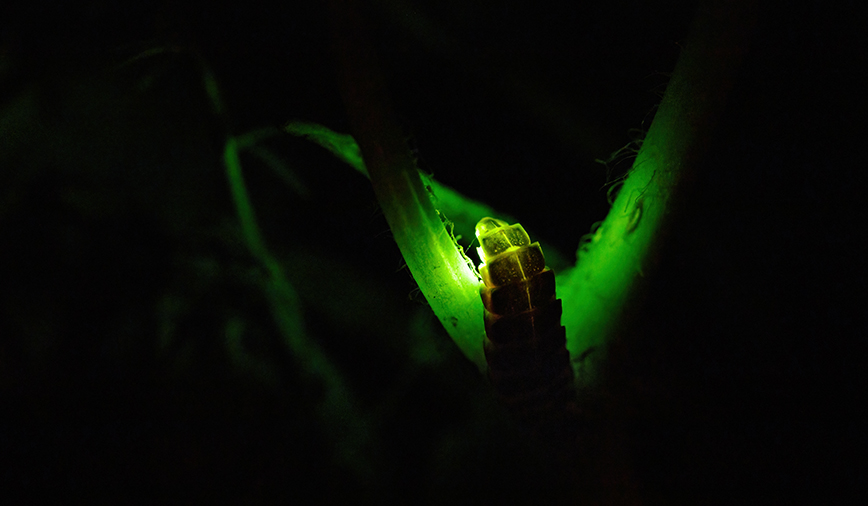Pam’s Perspective
C:\Users\selm\Desktop\Glowworm Phengodes.jpg
From the…
Pam Otto is the Manager of Natural Programs and
Interpretive Services for the St. Charles Park District
June 28, 2013
Life at Hickory Knolls is filled with many bright spots, small discoveries and tiny triumphs that make our
outlook just a little bit sunnier. Like the day last week when no one on staff –not a single person– found
any ticks crawling on them. Or like Tuesday of this past week, when we got through an entire day of
nature camp, lightning and thunder and all, without anybody—kids or staff– crying.
Two weeks ago actually was our brightest spot to date.
That was when Greg Pipis, a member of our ecological
restoration team, found an insect that got us positively
glowing.
In fact, the insect itself was glowing. For it was, we soon
discovered, a glowworm.
But this wasn’t any ordinary glowworm, no sirree. The
“usual” glowworms we run into are juveniles of the family
Lampyridae, the lightning bugs or fireflies. These little
larvae look a lot like streamlined pillbugs (a.k.a. roly-
polies) and sowbugs, but have only six legs. Oh, and they
glow, faintly, all the time.
Greg’s glowworm was another creature entirely. At 1 ½
in. in length, it was bigger. And with bioluminescent spots
along its sides, coupled with glimmering bands along its
back, it was a whole lot brighter.
It was—actually, still is, as it’s living on my desk, for now—a member of the Phengodidae, or glowworm
beetle family.
From the Greek phengodes, or “shining,” the Phengodidae consist of about 35 genera worldwide, with a
large number found in Central and South America. According to BugGuide.net, my favorite on-line field
guide, the family has six genera with ranges north of Mexico; these genera encompass 23 species across
the United States and southern Canada.
Twenty-three may sound like a pretty large number, especially if insect species aren’t in your Nature Top
10. But when you consider that the U.S. is home to about 25,000 different species of beetles (28,000 if
you throw in an estimate of those not yet described), you start to realize just how unusual these little
guys are.
After poring over what little material is available in our reference books and online, we’re maybe 90%
sure that Greg’s glowworm is an adult female in the genus Phengodes; were also about 50% certain that
the species is plumosa—a name that refers to the male beetle’s plume-like antennae.
Among glowworm beetles, only the males achieve a form we would consider to be a true adult—two
eyes, three identifiable body parts and, in this case, those incredible antennae. Females, by contrast, are
referred to as larviform; that is, they look like juveniles their entire lives.
This look apparently is what male Phengodidae find eye catching; it’s also what caused Greg to take a
second look. When he first saw the insect lying in the dirt, he thought it might be a larva of the dreaded
emerald ash borer. But closer inspection revealed that brilliant bioluminescence.
Animals that glow typically don’t do so without a purpose. Light can be used to lure in prey, ward off
predators and to attract a mate. But among the Phengodidae, no one’s really sure what the actual
function is. Some literature states that the glow plays no role in courtship, and is strictly there to warn
potential predators of the beetles’ icky taste. Other references say that males are programmed to look
for the glow, then use pheromones to track down individual females.
Something else the research hasn’t helped us with is diet. Everything we’ve been able to find so far
states that glowworm larvae and mature females are predatory, feeding on millipedes. We even found a
detailed account of how glowworm larvae use their mandibles to pierce millipedes in just the right spot;
the bite evidently paralyzes the millipede and renders it unable to discharge the benzoquinones that are
its only means of defense. A-mazing!
Yet when Greg first found this glowworm, he put some leaves in with her…and she ate them! Even now,
two weeks later, she appears to be thriving on a diet of leaves from several common lawn plants—
violets, plantain, clover and dandelions, to name a few.
The millipedes, which we added to her micro-ecosystem after “educating” ourselves, have gone
untouched, as have the sowbugs, nematodes and myriad other creatures living in the soil into which she
burrows each day.
Did Greg find a new species? Are we harming the habitat from which she came by keeping her in a cup?
We figure the answer to the first question probably is no (even though P. pipii does have a certain ring
to it). And we’re hoping the same is true of the second question as well. Besides, any day now, Greg will
be taking his glowworm back to where he found her, so she can go back to doing the things she does
best: eating whatever she prefers in her natural environment and attracting male Phengodidae with her
radiant glow.
We’ll keep beaming too, knowing that these magnificent, and unusual, creatures are living nearby,
making our days, and nights, brighter with their presence.
Pam Otto is the manager of nature programs and interpretive services at the Hickory Knolls Discovery
Center, a facility of the St. Charles Park District. She can be reached at 630-513-4346 or

